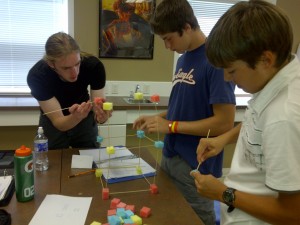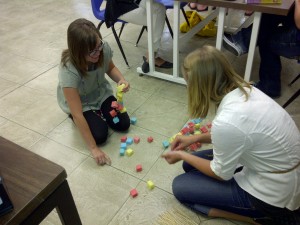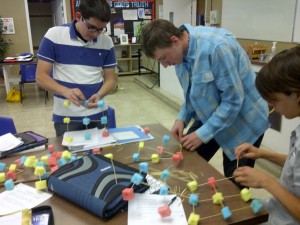 I love the first day of school, as much now as when I was a child. The reason I love it so much? I have an inquiry classroom.
I love the first day of school, as much now as when I was a child. The reason I love it so much? I have an inquiry classroom.
I teach chemistry and biology, both are inquiry and project-based. However, it looks different in each class.
In my chemistry class, my students have been wrestling with basic scientific concepts — the scientific method, mixtures, and different methods of separating heterogeneous and homogenous substances.
Day One: Building some context
The first day, we began with a lab. Constructivism tells us that new knowledge must build on previous knowledge. So we began with building towers. The task was to build a tower, as tall as each lab group could, using toothpicks and sponges cut into one inch squares. Each group had ten minutes. Upon hearing the assignment, one of my students said to me, “This isn’t scary at all. I thought Chemistry would be really scary and hard, but I can do this.”
One might think this is an easy task, and that’s mostly true, but some of the towers were pretty precarious. After 10 minutes of construction (or sooner if the structure was about to topple) we measured the results. The highest was about 36 inches.
Their next task was to build a second tower. However, this time they could change one of the variables, either the toothpicks for long skewers, the sponges for a different type of sponge, or the design itself. The goal? To create a taller tower.
Before we began this activity, I introduced the scientific method — purpose, hypothesis, materials, procedure, results, and conclusion — which gives them a way to think through what and how they were building.
Many groups took the skewers. Some were able to build taller towers with them, some were not. It all depended on the design they started with. One group realized early during their experiment that taking the skewers was a mistake. The skewers made their design too flimsy to stand up.
Ultimately, most groups were able to build taller towers; the tallest was 85 inches. What does this have to do with chemistry specifically? Nothing. With the scientific method? Everything. The day after the experiment, we had a shared experience for reference as we talked about things like qualitative and quantitative data, dependent and independent variables, and why there can only be one independent variable. They were able to attach all of these scientific words to knowledge they built the previous day.
Unit one done. No notes. No test.
Day Three: Inquiring minds want to know
On day three, we looked at mixtures. Normally we would take notes about heterogeneous & homogeneous mixtures. Not this year. At the beginning of class, my students watched me pour 1 kg of salt, 500g of sand, and 250g of pepper into a big bowl. I mixed it together. I looked at my students and said, “Now separate them.”
They weren’t given a recipe lab to follow. They had to create their own procedure, likely for the first time ever in school.
As far as I know, cutting edge scientists don’t rely on prepackaged experiments in lab research. Rather, they need to understand the underpinning scientific principles well enough to know how to apply them in any particular situation. So shouldn’t my classroom promote that knowledge and those skills? I wonder how much the science we teach in our classrooms resembles what chemists or biologists actually do.
I find in chemistry, it’s not always the what that is most important, it’s the why. Students can follow a recipe lab from beginning to end, reach the correct outcome, and have no idea why any of it occurred. It’s common to find students performing labs where they do things like determine which of two paper towel brands is the most absorbent. That’s not science. That’s product testing. Students can determine absorbency without knowing why paper towels absorb in the first place — or what factors make them more or less able to soak things up.
A group of students asked if they could use Google. Nope. While I love Google, for this lab, it was not an option. I want my students to learn to think and problem-solve.
The creativity they exhibited as they sought to separate the mixture was incredible. A number of groups dumped their mixture into water, which dissolved the salt. The mixture was then poured through a funnel with filter paper. The salt was removed this way. A few groups then dumped the sand and pepper into another beaker of water. The sand sank and the pepper floated. Pretty smart. The pepper could then be skimmed off the top, separating the pepper from the sand. Most groups boiled the water to evaporate it.
One of my students, at the outset of the experiment, asked for a balloon. I thought, “what in the world are you going to do with that?” She rubbed it on the hair of a fellow group member, and placed it above the mixture. It pulled the pepper out of the mixture, and it stuck to the balloon. Brilliant.
Pepper has a negative charge and the balloon, because of the electricity created, had a positive one. Never in a million years would I have thought of that, and I told them as much.
Day Four: Failure reigns
On day four, I ask my students if they know what creates colour. They don’t, but they tell me the spectrum is ROYGBIV. Well, we have to start somewhere. So if black isn’t part of the spectrum, how is it created? A few students suggest that colours are combined to create black. They’re right. I hold up a black marker and tell them their job is to separate the colours. Again, no recipe lab.
I also show them a beaker of saturated sugar-water. Their job is to separate the sugar from the water. The only stipulation is that they can’t boil it.
I have never had students work so hard to solve a problem and fail so badly. Different groups tried filter paper in combination with rubbing alcohol, iodine, vinegar, peroxide, bleach. Nothing they tried worked, which, for me, is a bit shocking. I was certain they would know how to do it because they’ve either seen, or been told about, this experiment at a younger grade. It makes me wonder just how much scientific knowledge from previous grades my students have actually retained.
At one point, one of my students looked at me and said, “I think we’ve learned every way not to separate the colours in black ink.” And that’s not unusual in science. For the first time in my teaching, I had meaningful conversations with my students about the high failure rate of real scientific experiments and the tenacity it takes to do scientific research. Failing isn’t a bad thing. It’s one experiment closer to finding the answer.
I wonder how many of our students think that scientific research splits nicely into one-hour chunks and always comes with a tidy conclusion at the end?
A few groups thought to use a string in the sugar-water; with enough time sugar crystallizes on the string. Other groups did not. At one point, a student was talking about using a device to split the water molecules so that only the sugar would remain. This experiment allowed me to talk to my students about Occam’s Razor, which states that among competing hypotheses, it’s usually best to select the one that makes the fewest new assumptions.
I first learned about Occam’s razor (or the law of parsimony) in Biology 100, during my first year of university. Until now, I’d never used it. Never had a need to. But students using inquiry for the first time devise some pretty complicated solutions that often don’t work.
In the end, very few students had an experiment that was successful. After we talked about how to reach the intended conclusion, my students asked if they should write what actually happened in their lab, even though it was a failure, or if instead they might write about what should have happened. My students have an aversion to failure, likely from years of experiencing a grading system that imprints failure is bad and to be avoided at all costs, even if you have to falsify your report.
These last three experiments allowed us to talk about additional scientific words: distillation, crystallization, filtration, soluble and insoluble, and other expressions and processes involved in separating solutions.
Five days. Two units completed. A few notes on the wiki. No exams.
Messy and real
This is the first time since I began teaching science that I’ve had real conversations about what science looks and feels like, and it’s a mess. There’s more failure than success, but we’re still at the beginning. The most exciting thing is that I have students who are fully engaged in the pursuit of scientific discovery. For the first time, my students have been responsible for creating their own labs — from purpose to conclusion.
This week I’ve come to question the most common procedures that we use to transmit knowledge and gauge learning. I wonder how and why notes and tests became the summation of our student’s acquisition of knowledge and understanding, and what it will take to put us back on the path to real learning.
Shelley Wright
Latest posts by Shelley Wright (see all)
- Start with Why: The power of student-driven learning - May 8, 2019
- Are You Ready to Join the Slow Education Movement? - August 26, 2014
- Academic Teaching Doesn't Prepare Students for Life - November 7, 2013



Shelley, thank you so much for sharing your approach to instruction. I work with schools as a coach for Authentic Intellectual Work, and it is so refreshing to see a teacher putting students in the shoes of scientists (or historians, artists, etc.) in order to provide authentic learning experiences for them. I’m sure your students are learning far more than they would ever learn using a traditional approach to teaching. Kudos to you!
Thanks, Teresa. Your words are encouraging!
Shelly,
From your posting, it almost makes me wish I was in your classroom as a student! Amazing! So much of scientific experiment leads to failure. I believe that failure is absolutely important in the learning process! But in an environment that you described, failure does not that the stigma that it normally has. Keep up the good work!!!
Thanks, Sister Geralyn. I only wish our students could learn from the beginning that failure is not a bad thing. It’s something to learn from, and can be embraced for that reason.
Dear Shelley,
Thank you so much for writing this post. This kind of learning is definitely messy and scary. But not so much that, as an adult, I shouldn’t take on the challenge of offering the gigantic benefits to my students.
I read what you’ve written and what most pops out for me is the way in which your students will now go about thinking about science. The structures you’ve created seem more real-world than the normal classroom….I think that’s your whole point in doing this.
What would happen if every teacher started teaching without knowing the “answers” at the end of the lab? What if we, as you have,learned alongside our students. Definitely a game changer in that students would take part of the power we noramlly hold. Yet I think we would actually re-invest anything we “lost” in a different kind of relationship with them. One that would be more powerful for them in the longrun, I think.
Failure can only be bad, in my mind, if we learn nothing from the experience. And, as you’ve pointed out, if you learn valuable information that can be used for the next phase of the work, then it’s actually incredibly beneficial.
Thanks for writing this post and helping so many of us imagine what could be by reading a real-life example of what already is!!!
marsha
Thanks, Marsha. I really appreciate your words, since I know you live this out in your classroom too.
I certainly agree with your statement that there needs to be a shift in power. I think teachers are often afraid that they won’t be able to “control” their classroom, if some of that power is given up. But, in truth, I’ve found the opposite. My students don’t care if I know all of the answers. Not knowing makes me a real person. And that changes the relationship for the better.
Great post. Great inquiry. You should join us at Inquire Within, a collaborative blog about inquiry. Would you cross post this there? http://inquiryblog.wordpress.com/
Dear Shelley,
I think this is such a great approach to learning. I wonder if you are thinking of how you will cover all the traditional chemistry content within this format or if you are redesigning all around process and not worrying so much about coverage of content?
I also have a question about external assessments. Are there external –as in national or provincial exams or things like the SAT Chemistry subject test for which you have to prepare your students?
I still have to teach all of the traditional content that is part of a typical chemistry class. Our chemistry splits into 20 & 30 levels. At the end of chem 30, my students have to write a provincial exam.
Some of the content we’ll learn by experiment, some my students will learn by researching and creating their own notes. I also use the flipped classroom approach for teaching content, when my students need small chunks of information to keep moving forward. And likely for formulas, I’ll use direct instruction.
I think this is a much more balanced, student-centred approach than lecturing all the time. My students seem to enjoy it more too!
Suppes, a veteran of Paris’ haute couture and readytowear shows, said audiences often had high expectations. “You didn’t know what to expect, but you knew it was going to be gorgeous and beautifully constructed, and you know it could be outrageous.”
Hi Shelley,
I love the sounds of your classroom and am currently working with my chemistry department to builds our classrooms around more student cantered learning like this.
Are there specific resources that you can suggest to find ideas for lessons and activities?
Thanks for your help, feel free to email me.
Cheers